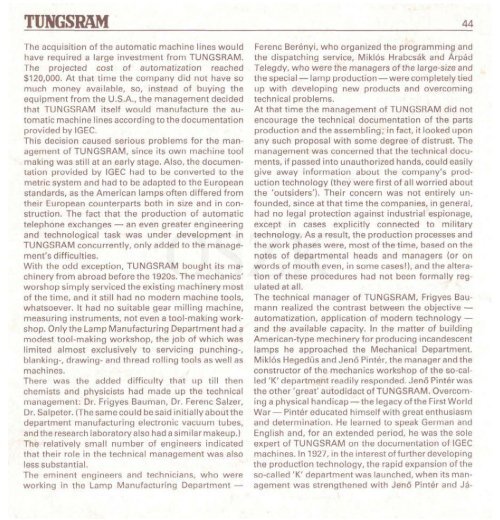THE HISTORY OF TUNGSRAM 1896-1945 - MEK
THE HISTORY OF TUNGSRAM 1896-1945 - MEK
THE HISTORY OF TUNGSRAM 1896-1945 - MEK
- No tags were found...
You also want an ePaper? Increase the reach of your titles
YUMPU automatically turns print PDFs into web optimized ePapers that Google loves.
<strong>TUNGSRAM</strong>• \ ^ .44The acquisition of the automatic machine lines wouldhave required a large investment from <strong>TUNGSRAM</strong>.The projected cost of automatization reached$120,000. At that time the company did not have somuch money available, so, instead of buying theequipment from the U.S.A., the management decidedthat <strong>TUNGSRAM</strong> itself would manufacture the automaticmachine lines according to the documentationprovided by IGEC.This decision caused serious problems for the managementof <strong>TUNGSRAM</strong>, since its own machine tool' V making was still at an early stage. Also, the documentationprovided by IGEC had to be converted to themetric system and had to be adapted to the Europeanstandards, as the American lamps often differed fromtheir European counterparts both in size and in construction.The fact that the production of automatictelephone exchanges — an even greater engineeringand technological task was under development in<strong>TUNGSRAM</strong> concurrently, only added to the management'sdifficulties.With the odd exception, <strong>TUNGSRAM</strong> bought its machineryfrom abroad before the 1920s. The mechanics'worshop simply serviced the existing machinery mostof the time, and it still had no modern machine tools,whatsoever. It had no suitable gear milling machine,measuring instruments, not even a tool-making workshop.Only the Lamp Manufacturing Department had amodest tool-making workshop, the job of which waslimited almost exclusively to servicing punching-,blanking-, drawing- and thread rolling tools as well asmachines.There was the added difficulty that up till thenchemists and physicists had made up the technicalmanagement: Dr. Frigyes Bauman, Dr. Ferenc Salzer,Dr. Salpeter. (Thesame could be said initiallyaboutthedepartment manufacturing electronic vacuum tubes,and the research laboratory also had a similar makeup.)The relatively small number of engineers indicatedthat their role in the technical management was alsoless substantial.The eminent engineers and technicians, who wereworking in the Lamp Manufacturing Department —Ferenc Berenyi, who organized the programming andthe dispatching service, Miklos Hrabcsak and ArpadTelegdy, who were the managers of the large-size andthe special — lamp production — were completely tiedup with developing new products and overcomingtechnical problems.At that time the management of <strong>TUNGSRAM</strong> did notencourage the technical documentation of the partsproduction and the assembling; in fact, it looked uponany such proposal with some degree of distrust. Themanagement was concerned that the technical documents,if passed into unauthorized hands, could easilygive away information about the company's productiontechnology (they were first of all worried aboutthe 'outsiders'). Their concern was not entirely unfounded,since at that time the companies, in general,had no legal protection against industrial espionage,except in cases explicitly connected to militarytechnology. As a result, the production processes andthe work phases were, most of the time, based on thenotes of departmental heads and managers (or onwords of mouth even, in some cases!), and the alterationof these procedures had not been formally regulatedat all.The technical manager of <strong>TUNGSRAM</strong>, Frigyes Baumannrealized the contrast between the objective —automatization, application of modern technology —and the available capacity. In the matter of buildingAmerican-type mechinery for producing incandescentlamps he approached the Mechanical Department.Miklos HegediJs and Jeno Pinter, the manager and theconstructor of the mechanics workshop of the so-called'K' department readily responded. Jeno Pinter wasthe other 'great' autodidact of <strong>TUNGSRAM</strong>. Overcominga physical handicap — the legacy of the First WorldWar — Pinter educated himself with great enthusiasmand determination. He learned to speak German andEnglish and, for an extended period, he was the soleexpert of <strong>TUNGSRAM</strong> on the documentation of IGECmachines. In 1927, in the interest of further developingthe production technology, the rapid expansion of theso-called 'K' department was launched, when its managementwas strengthened with Jeno Pinter and Ja-








![Letöltés egy fájlban [4.3 MB - PDF]](https://img.yumpu.com/50159926/1/180x260/letaltacs-egy-fajlban-43-mb-pdf.jpg?quality=85)







